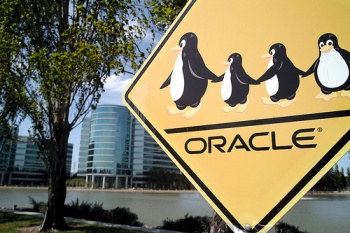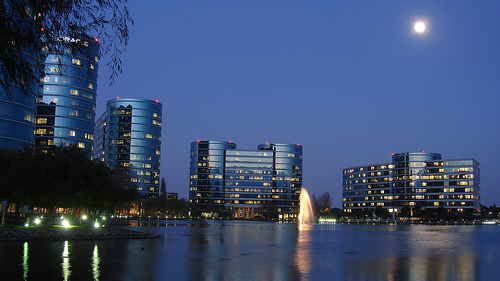Oracle Corporation


Oracle Corporation (NASDAQ: ORCL) is one of the largest software development companies in the world.
Company history[edit]
Oracle was established in 1977 and has offices in more than 145 countries around the world. As of 2005, its employee count was over 50,000 worldwide.
Larry Ellison (Lawrence J. Ellison) has served as Oracle's CEO for several years. Ellison served as the chairman of the board until his replacement by Jeff Henley in 2004. Ellison retains his role as CEO. Forbes magazine once judged Ellison the richest man in the world.
Ellison was inspired by the paper written by Edgar Codd on relational database systems named A Relational Model of Data for Large Shared Data Banks. He had heard about the IBM System R database, also based on Codd's theories, and wanted Oracle to be compatible with it, but IBM stopped this by keeping the error codes for their DBMS secret. He founded Oracle in 1977 under the name Software Development Laboratories. In 1979 SDL changed its name to Relational Software, Inc. (RSI). In 1983, RSI was renamed Oracle Corporation to more closely align itself with its flagship product Oracle database with Howard Johns as senior programmer.
Headquarters[edit]
Oracle's HQ buildings are located in Oracle Parkway, Redwood Shores, California, USA. These buildings were featured in the 1999 film, the Bicentennial Man. Here is a photo:
Contact details[edit]
Use the following contact details to get in touch with Oracle Corporation:
- Home Page: http://www.oracle.com
- Phone: (650) 506-7000
- Fax: (650) 506-7200
Postal address:
Oracle Corporation 500 Oracle Parkway Redwood Shores, CA 94065 United States of America
Product overview[edit]
Oracle provided a vast range of products and services. For a detailed list, see Oracle Product Set and Oracle Services.
In summary - they provide the following software solutions:
- database management systems (Oracle Database, Oracle RDB, TimesTen, Berkeley DB, etc.)
- tools for database development (Oracle Developer Suite - Forms, Reports, JDeveloper, etc.)
- application server (OC4J, Portal, SSO, etc)
- enterprise resource planning software (ERP)
- customer relationship management software (CRM)
- supply chain planning software (SCM)
Competitors[edit]
Oracle's main competitors in the database business are:
- Microsoft SQL Server
- IBM with DB2 and Informix
- Sybase with their Sybase System
- CA with Ingres
- Software AG with ADABAS and MaxDB
Open source databases (free, but normally way behind their commercial equivalents):
Oracle's main competitors in the middleware/ application servers business are:
- IBM WebSphere
- BEA WebLogic (until January 2008 when they bought the company)
Oracle's main competitors in the applications business are:
- SAP R/3
Sponsorships[edit]
Oracle sponsors the following charities and sports clubs:
- the Golden State Warriors basketball team. The Oakland Arena was re-branded as the Oracle Arena.
- Oracle BMW Racing - a yachting syndicate that participates in the America’s Cup.
Oracle history[edit]
Here is a summary of Oracle's history. For details, look at the year pages:
- 1977 - Relational Software Inc. (RSI - currently Oracle Corporation) established.
- 1978 - Oracle 1 ran on PDP-11 under RSX, 128 KB max memory. Written in assembly language. Implementation separated Oracle code and user code. Oracle V1 was never officially released.
- 1980 - Oracle 2 released - the first commercially available relational database to use SQL. Oracle runs on on DEC PDP-11 machines. Code is still written in PDP-11 assembly language, but now ran under Vax/VMS.
- 1982 - Oracle 3 released, Oracle became the first DBMS to run on mainframes, minicomputers, and PC's (portable code base). First release to employ transactional processing. Oracle V3's server code was written in C.
- 1983 - Relational Software Inc. changed its name to Oracle Corporation.
- 1984- Oracle 4 released, introduced read consistency, was ported to multiple platforms, first interoperability between PC and server.
- 1986 - Oracle 5 released. Featured true client/server, VAX-cluster support, and distributed queries. First DBMS with distributed capabilities.
- 1987 - CASE and 4GL toolset
- 1988 - Oracle 6 released - PL/SQL introduced. Oracle Financial Applications built on relational database.
- 1989 - Released Oracle 6.2 with Symmetric cluster access using the Oracle Parallel Server
- 1991 - Reached power of 1,000 TPS on a parallel computing machine. First database to run on a massively parallel computer (Oracle Parallel Server).
- 1992 - Released Oracle 7 for Unix
- 1993 - Rollout of Oracle's Cooperative Development Environment (CDE). Introduction of Oracle Industries and the Oracle Media Server.
- 1994 - Oracle's headquarters moved to present location. Released Oracle 7.1 and Oracle7 for the PC.
- 1995 - Reported gross revenues of almost $3 billion.
- 1995 - OraFAQ.com website launched.
- 1997 - Oracle 8 released (supports more users, more data, higher availability, and object-relational features)
- 1998 - Oracle announces support for the Intel Linux operating system
- 1999 - Oracle 8i (the "i" is for internet) or Oracle 8.1.5 with Java integration (JVM in the database)
- 2000 - Oracle 8i Release 2 released. Oracle now not only the number one in Databases but also in ERP Applications. Oracle9i Application Server generally available: Oracle tools integrated in middle tier.
- 2001 - Oracle 9i Release 1 (with RAC and Advanced Analytic Service)
- 2002 - Oracle 9i Release 2
- 2004 - Oracle 10g Release 1 (10.1.0) available ("g" is for grid, the latest buzzword)
- 2005 - The Oracle FAQ (this site) is 10 years old! Oracle 10g Release 2 (10.2.0) available. Oracle released a free version of their database, called Oracle XE (Express Edition)
- 2006 - Oracle announced their Unbreakable Linux program
- 2007 - Oracle 11g release 1 available
- 2009 - September Oracle 11g release 2 is available
Oracle acquisitions[edit]
Oracle recently acquired the following companies:
- Oracle Rdb Server from Digital Equipment Corporation (DEC) formerly known as DEC Rdb - 1994 - a relational database management system (RDBMS) for mission-critical systems running on Hewlett-Packard's OpenVMS operating system only
- Omniscience - November 1996 - Oracle Lite
- Darwin - June 1999 - Darwin, Datamining technology
- Steltor - June 2002 - Enterprise calendaring system
- PeopleSoft - January 2005 - Enterprise applications (competitor to E-Business Suite).
- Oblix - March 2005 - Identity management solutions. Also see Web Services Manager.
- Retek - April 2005 - retail solution, including back-office functionality for finance and human resources and extends to planning, merchandising, supply chain, and retail channels
- TripleHop - June 2005 - context-sensitive enterprise search products and technology.
- ProfitLogic - July 2005 - retail industry's most comprehensive software solution, helping create tightly integrated, customer- insight-driven retail enterprises
- Context Media - July 2005 - enterprise content integration (ECI) software
- i-flex - August 2005 - banking industry
- G-Log - September 2005 - Logistics Hub solution for global supply chain and logistics management
- Thor Technologies - November 2005 - enterprise-wide user provisioning solution
- OctetString - November 2005 - virtual directory, identity and access management offerings
- TempoSoft - December 2005 - managing time and labour, absences, and scheduling to meet a forecasted workload demand
- 360Commerce - January 2006 - merchandising, supply chain, and optimization solutions, from the enterprise to the store
- Siebel - January 2006 - Enterprise applications (competitor to E-Business Suite).
- Sleepycat - February 2006 - Berkeley DB, open source database for developers of embedded applications
- HotSip - February 2006 - middleware and carrier-grade communications infrastructure
- Portal Software - April 2006 - end-to-end packaged enterprise software suite for the communications industry. See Oracle BRM.
- Net4Call - April 2006 - Service Delivery Platform (SDP) for the telecommunications industry
- Demantra - June 2006 - demand-driven planning solutions
- Telephony@Work - June 2006 - CRM applications provider to unify IP-based contact center technology and CRM software to deliver a complete "customer to agent" experience
- Sigma Dynamics - August 2006 - leverage the insight contained in both historical and real-time data sources to drive better decisions in practically any situation
- Sunopsis - October 2006 - high-performance, next-generation data integration capabilities. See Oracle Data Integrator
- MetaSolv Software - October 2006 - key business processes of the communications industry
- Stellent - November 2006 - content management solution
- SPL WorldGroup - November 2006 - packaged solution to meet the unique needs of the utilities industry
- Hyperion - March 2007 - enterprise performance management
- Tangosol - March 2007 - extreme transaction processing
- AppForge - April 2007 - mobile applications
- LODESTAR - April 2007 - utilities applications, meter data management and energy operation solutions
- Agile - May 2007 - Enterprise Product Life Cycle Management Software
- Bridgestream, Inc - September 2007 - Enterprise Role Management and role mining
- Interlace Systems - November 2007 - Enterprise Performance Management (EPM) software
- BEA Systems, Inc - January 2008 - Middleware provider (Tuxedo, Weblogic, etc)
- Captovation - January 2008 - Document capture software
- Empirix (Web) - March 2008 - Web application testing software
- Skywire Software - June 2008 - Insurance software
- Global Knowledge Software - July 2008 - Technical Writing/Training Authoring software
- ClearApp - September 2008 - Application management solutions for composite applications software
- Primavera Systems - October 2008 - Project Portfolio Management solutions software
- Haley Limited - October 2008 - Policy modeling and automation software
- SUN Microsystems - April 2009 - Solaris OS, Java, MySQL, SPARC, and other hardware products

